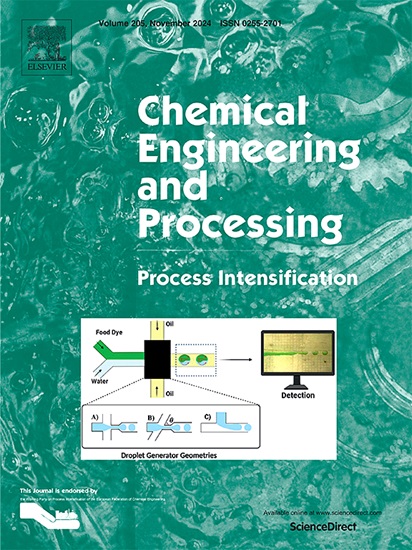A novel approach to heat removal and temperature control in fed-batch extractive ethanol fermentation using CO2
IF 3.8
3区 工程技术
Q3 ENERGY & FUELS
Chemical Engineering and Processing - Process Intensification
Pub Date : 2025-02-09
DOI:10.1016/j.cep.2025.110212
引用次数: 0
Abstract
This study proposes a novel approach to remove heat and maintain the broth temperature constant during fed-batch ethanol extractive fermentations by using a carbon dioxide (CO2) flow rate. The method offers an alternative to traditional cooling methods, such as water-based plate heat exchangers, which can be inefficient in distilleries located in hot regions. A mathematical model was developed and used to find the optimal CO2 flow rate to maintain constant the broth temperature in simulated fermentations at 30, 32, and 34 °C. The results showed that using multiple CO2 flow rates over an 8-hour stripping period could effectively reduce temperature deviations from the set-point while minimizing the total amount of CO2 used. However, finding the optimal combination of flow rates becomes computationally expensive as the stripping period is split in a greater number of time subintervals. A comprehensive study was carried out to assess the adequate number of time subintervals to keep the broth temperature constant. Experimental fermentation carried out at 34 °C using eight-time subintervals confirmed the accuracy of the model's predictions. A temperature deviation of less than 0.5 °C from the set-point highlights the potential of extractive fermentation for controlling temperature and offers insights to enhance process efficiency.

一种利用CO2进行分批进料乙醇发酵脱热和温度控制的新方法
本研究提出了一种利用二氧化碳(CO2)流速在进料分批乙醇提取发酵过程中去除热量并保持肉汤温度恒定的新方法。该方法提供了一种替代传统冷却方法的方法,例如水基板式热交换器,这种方法在位于炎热地区的酿酒厂中效率低下。建立了一个数学模型,并利用该模型找到了在30、32和34℃的模拟发酵中保持肉汤温度不变的最佳CO2流速。结果表明,在8小时的汽提周期内,采用多种CO2流量可以有效地减少温度与设定值的偏差,同时最大限度地减少CO2的总用量。然而,由于剥离周期被划分为更多的时间子区间,寻找最优的流量组合在计算上变得非常昂贵。进行了一项全面的研究,以评估保持肉汤温度恒定的适当时间亚间隔。在34°C下使用8次亚间隔进行的实验发酵证实了模型预测的准确性。从设定值的温度偏差小于0.5°C,突出了萃取发酵控制温度的潜力,并提供了提高工艺效率的见解。
本文章由计算机程序翻译,如有差异,请以英文原文为准。
求助全文
约1分钟内获得全文
求助全文
来源期刊
CiteScore
7.80
自引率
9.30%
发文量
408
审稿时长
49 days
期刊介绍:
Chemical Engineering and Processing: Process Intensification is intended for practicing researchers in industry and academia, working in the field of Process Engineering and related to the subject of Process Intensification.Articles published in the Journal demonstrate how novel discoveries, developments and theories in the field of Process Engineering and in particular Process Intensification may be used for analysis and design of innovative equipment and processing methods with substantially improved sustainability, efficiency and environmental performance.

 求助内容:
求助内容: 应助结果提醒方式:
应助结果提醒方式:


